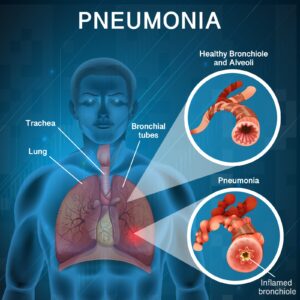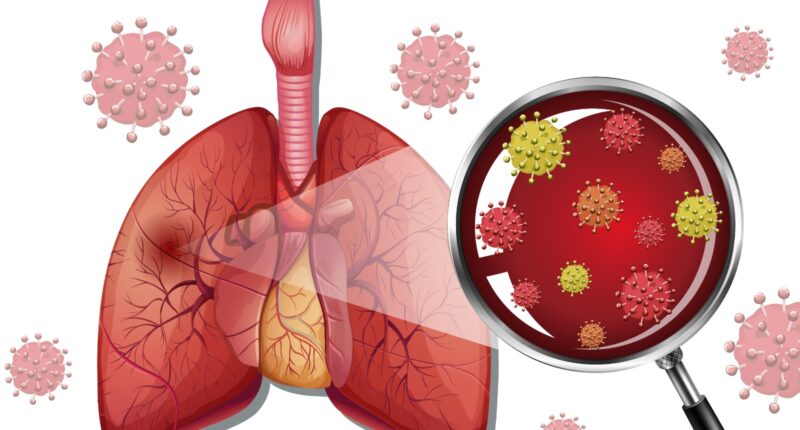Pneumonia is a common yet serious lung infection that affects millions of people worldwide every year. It occurs when the air sacs in the lungs, known as alveoli, become inflamed and filled with fluid or pus, making it difficult to breathe. Pneumonia can vary in severity, from mild cases to life-threatening conditions, depending on several factors, including the type of pneumonia. Understanding the different types of pneumonia is crucial for recognizing symptoms, seeking treatment, and preventing complications.
1. Bacterial Pneumonia
Bacterial pneumonia is one of the most common forms of the illness. It is caused by various bacteria, with Streptococcus pneumoniae being the most common culprit. Bacterial pneumonia typically occurs when the immune system is weakened or compromised, allowing bacteria to invade the lungs. People with chronic illnesses, the elderly, and young children are especially vulnerable to bacterial pneumonia.
Symptoms:
- High fever
- Rapid breathing
- Chest pain, especially when breathing or coughing
- Productive cough with yellow or green mucus
- Fatigue
Bacterial pneumonia often comes on suddenly, and treatment usually involves antibiotics, which are effective in most cases. However, severe cases may require hospitalization, especially if breathing difficulties arise.
2. Viral Pneumonia
Viral pneumonia is caused by various viruses, such as the influenza virus, respiratory syncytial virus (RSV), or even the COVID-19 virus. It can affect people of all ages but is especially dangerous for infants, older adults, and people with weakened immune systems. Unlike bacterial pneumonia, antibiotics are not effective against viral infections. Instead, antiviral medications, rest, and supportive care are commonly prescribed.
Symptoms:
- Low-grade fever
- Dry cough
- Muscle aches
- Shortness of breath
- Fatigue
Viral pneumonia symptoms tend to develop gradually, and in some cases, they can be milder than bacterial pneumonia. However, it can still lead to serious complications, particularly in those with pre-existing health conditions.

3. Fungal Pneumonia
Fungal pneumonia is caused by inhaling certain fungi from the environment. This type of pneumonia is relatively rare and is more likely to affect people with weakened immune systems, such as those undergoing chemotherapy or living with HIV/AIDS. Some fungi that cause fungal pneumonia include Histoplasma, Coccidioides, and Cryptococcus. People living in certain geographic regions, like the American Southwest, are more at risk due to the presence of these fungi in the soil.
Symptoms:
- Fever
- Cough (sometimes with bloody mucus)
- Shortness of breath
- Chest pain
- Fatigue
Fungal pneumonia can be treated with antifungal medications. However, if left untreated, it can spread to other parts of the body, causing severe complications. Early diagnosis and treatment are essential for a better prognosis.
4. Aspiration Pneumonia
Aspiration pneumonia occurs when foreign substances, such as food, drink, or vomit, are inhaled into the lungs, causing an infection. This type of pneumonia is common in people who have difficulty swallowing, are unconscious, or suffer from certain neurological conditions like stroke or dementia.
Symptoms:
- Cough (with foul-smelling or greenish phlegm)
- Shortness of breath
- Fever
- Difficulty swallowing
- Chest discomfort
Aspiration pneumonia can be particularly dangerous because it often involves inhalation of stomach acids, which can severely damage lung tissue. Treatment typically includes antibiotics, and in some cases, hospitalization may be required to monitor and manage breathing difficulties.
5. Hospital-Acquired Pneumonia (HAP)
Hospital-acquired pneumonia (HAP) is a form of bacterial pneumonia that occurs during or after a hospital stay, typically after being on a ventilator or having surgery. It is considered one of the most serious types because it often involves antibiotic-resistant bacteria, making treatment more challenging.
Symptoms:
- Severe cough
- Fever and chills
- Rapid heart rate
- Difficulty breathing
- Increased mucus production
Hospital-acquired pneumonia requires immediate medical attention and treatment with strong antibiotics. People with weakened immune systems or those in intensive care are at greater risk of developing HAP.
6. Community-Acquired Pneumonia (CAP)
Community-acquired pneumonia (CAP) is pneumonia contracted outside of healthcare settings, such as at home or work. It is the most common type of pneumonia and can be caused by bacteria, viruses, or fungi. CAP can affect individuals of any age, but young children, older adults, and people with chronic diseases are more susceptible.
Symptoms:
- Chest pain
- Cough (with or without mucus)
- Shortness of breath
- Fever and sweating
- Fatigue
CAP is usually treatable with antibiotics or antivirals, depending on the cause. Prompt medical intervention is important to prevent complications such as respiratory failure.
Conclusion
Pneumonia is a diverse illness with various causes and symptoms, each requiring different treatment approaches. Recognizing the type of pneumonia you or a loved one may be suffering from is essential to receiving the right care. Whether it’s bacterial, viral, fungal, aspiration, or hospital-acquired pneumonia, early detection and medical intervention can significantly improve the outcome.
If you suspect pneumonia, it’s crucial to seek medical attention promptly, as untreated pneumonia can lead to severe complications, including lung damage, respiratory failure, and even death. Stay informed, protect yourself with vaccinations where applicable, and prioritize good hygiene practices to minimize the risk of contracting pneumonia.









